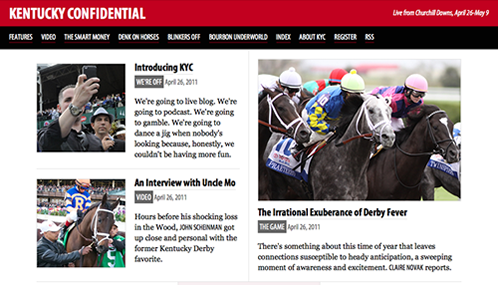Sneak Peek
… at Kentucky Confidential, which launches Tuesday. The first stories are coming in, the website is coming together …

The Countdown
If you’ve been thinking of pledging Kentucky Confidential, now’s the time. We’re in the final hours of our Kickstarter campaign, which ends Wednesday.
As your local NPR voices say during a pledge drive, it doesn’t matter if you give. Really! It doesn’t. We’re going to be at Churchill Downs starting April 26, publishing daily through May 9, and we know you’re going to enjoy our content, which will be the kind of stuff that gets linked, tweeted, and talked about. Kickstarter may be an all-or-nothing deal — if we don’t meet our funding goal by the deadline, we won’t receive any of the pledges that have been made — but Kentucky Confidential isn’t. Thanks to our sponsors, the Breeders’ Cup Betting Challenge and Woodford Reserve, as well as committed individual contributors, we’ll be in Louisville next week, bringing you stories from Derby history as well as the backstretch and parties.
But even if we don’t need you to support us, we’d love it if you did. Every dollar raised for Kentucky Confidential goes directly toward covering the costs of producing and publishing original turf journalism. Your contribution will come back to you in the form of stories that surprise and entertain, and handicapping analysis that gives you a fresh look at the past performances.
If you haven’t already, please pledge. We’ll reward your support.
4/21/11 Update: Our Kickstarter campaign successfully ended yesterday. We’re funded! Our thanks to all our contributors and sponsors.
Only Five Four Days Left
… to help support Kentucky Confidential, a shiny new website dedicated to capturing the essence of the Kentucky Derby in words, photos, and video.
The Kentucky Derby is one of the most heavily covered events in horse racing, but rare is the news outlet that treats it as one of the greatest storytelling platforms in American sports.
That’s how Kentucky Confidential will cover the 2011 Kentucky Derby.
What you’ll get:
True (and not-necessarily true) stories from the backstretch
Tall tales and little-known historical marvels from the Derby’s rich past
Kinky stats and contrarian handicapping
Straight-shooting, expert contender profiles and news
Lures and snares of Louisville nightlife and bourbon culture
Video from one of the underground’s best filmmakers
And that’s not all! If you back KYC, you’ll get goodies such as a Jeff Krulik Derby DVD or the chance to submit questions to Derby connections.
“… the opportunity is there to create something new. People who think race writing is a dying art, this is your opportunity to support it.”
We begin publishing April 26, and we’ll continue through May 9, running features and stories from writers such as Pete Denk, Claire Novak, Brendan O’Meara, and John Scheinman, illustrated by photos from Scott Serio.
We’ll be at Churchill in 11 10 days, and we’d love it if you joined us.
Copyright © 2000-2023 by Jessica Chapel. All rights reserved.